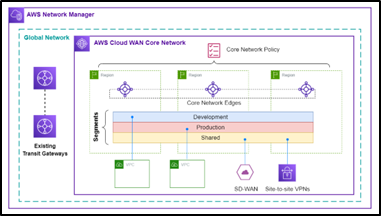|
Voiced by Amazon Polly |
Introduction
Amazon Web Services offer 250+ services covering all types of businesses, customers, and industries. In this article, we will discuss AWS Cloud WAN, one of the most important networking and content delivery services. Let’s discuss this service further in the following section.
As we can see in the following architecture diagram, existing transit gateways and AWS cloud WAN core network can coexist without indulging any complexity. Taking the burden of managing complex networks off the shoulders of customers, AWS cloud WAN automates and manages core network components.

Figure 1: Architecture diagram of AWS Cloud WAN
Pioneers in Cloud Consulting & Migration Services
- Reduced infrastructural costs
- Accelerated application deployment
Important key components
Following is the list of important key components of AWS Cloud WAN:
- AWS Network Manager – A unique consolidated view to manage network topologies, metrics, and events. Centrally manage a global network using the AWS Management Console user interface and associated APIs.
- Global Network – A single private network that acts as a root-level container for network objects. A global network can include both transit gateways and core networks.
- Core Network – The part of your global network managed by AWS. Virtual private networks (VPNs) and Amazon VPCs are examples of attachments and connection points in regional networks.
- Core Network Policy – A singular, versioned policy document outlining every element of your core network.
- Attachments – You can add any connections or resources to expand your core network. A VPC attachment, a VPN attachment, and a Connect attachment are supported.
- Core Network Edge (CNE) – In accordance with the policy, a regional connection point is established for your attachments. Technology such as Transit Gateway is used behind the scenes in Cloud WAN. Dynamic routing is an example of one difference (it is managed by AWS).
- Network Segments – Routing domains that, by default, only allow communication within a segment consistently throughout the global network. These are strongly enforced layer three routing domains (unless you create sharing relationships in your network policy).
Features
- Build global networks in minutes
- Use the AWS global network for hybrid connectivity
- Simplify WAN deployments and visibility
- Centralized traffic segmentation policy
Comparisons
AWS Transit Gateway and AWS Cloud WAN service seem similar to customers when they learn about their features and working mechanism, but they differ.

Pricing
Let’s investigate the pricing model of AWS Cloud WAN. There is an attachment per hour cost also data processing cost. It is important to notice that when we deploy Cloud WAN, we create a core network edge in the required AWS regions for the network. So basically, the pricing per region cost for the core network edge is also included.
Example for Asia Pacific (Mumbai)

Conclusion
In this article, we have discussed a new service from Amazon Web Services called AWS Cloud WAN, which helps to manage WANs on-premises and networking components in the cloud. There is still more to learn about AWS Cloud WAN, so I encourage you to see the official documentation from AWS.
Freedom Month Sale — Discounts That Set You Free!
- Up to 80% OFF AWS Courses
- Up to 30% OFF Microsoft Certs
- Ends August 31
About CloudThat
CloudThat is an award-winning company and the first in India to offer cloud training and consulting services worldwide. As a Microsoft Solutions Partner, AWS Advanced Tier Training Partner, and Google Cloud Platform Partner, CloudThat has empowered over 850,000 professionals through 600+ cloud certifications winning global recognition for its training excellence including 20 MCT Trainers in Microsoft’s Global Top 100 and an impressive 12 awards in the last 8 years. CloudThat specializes in Cloud Migration, Data Platforms, DevOps, IoT, and cutting-edge technologies like Gen AI & AI/ML. It has delivered over 500 consulting projects for 250+ organizations in 30+ countries as it continues to empower professionals and enterprises to thrive in the digital-first world.
FAQs
1. Can AWS Transit Gateway natively connect to AWS Cloud WAN?
ANS: – Transit Gateway can natively connect to the core network edge through a peering connection. When connecting a native transit gateway to AWS Cloud WAN, ensuring that the transit gateway and core network are located in the same AWS region is crucial. Both services can be in the same or different AWS accounts.
2. How is built-in automation achieved in AWS Cloud WAN?
ANS: – While working with AWS Cloud WAN, tagging achieves built-in automation. AWS Cloud WAN automatically attaches new VPCs to add network connections per your network’s requirement. Tagging is useful for deciding whether resources should be attached within a specific network policy automatically or manually.

WRITTEN BY Aishwarya Joshi
Aishwarya works as a Research Associate (AWS Media services) with CloudThat. She is an enthusiastic individual and a good team player. A positive attitude is her way of dealing with everything. She enjoys learning new technologies and exploring various ways of problem-solving. As of late, she has become proficient in cloud services and enjoys writing technical blogs.


 Login
Login


 March 23, 2023
March 23, 2023 PREV
PREV











Rutuja
Mar 27, 2023
Very informative 💯
Rakhee kulkarni
Mar 24, 2023
Best
Deepak Surendran
Mar 23, 2023
Good one